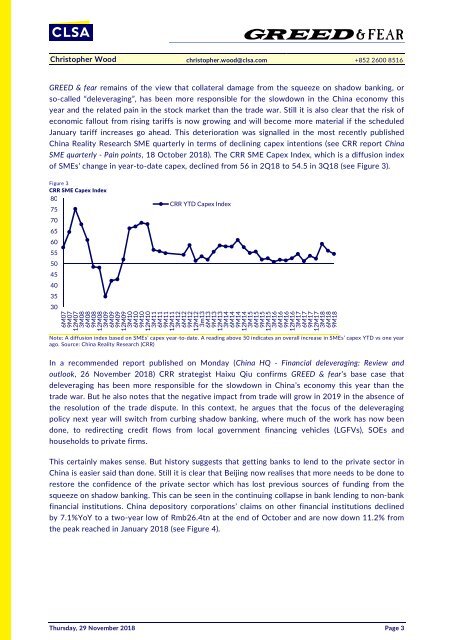Create successful ePaper yourself
Turn your PDF publications into a flip-book with our unique Google optimized e-Paper software.
Christopher Wood christopher.wood@clsa.com +852 2600 8516<br />
GREED & fear remains of the view that collateral damage from the squeeze on shadow banking, or<br />
so-called “deleveraging”, has been more responsible for the slowdown in the China economy this<br />
year and the related pain in the stock market than the trade war. Still it is also clear that the risk of<br />
economic fallout from rising tariffs is now growing and will become more material if the scheduled<br />
January tariff increases go ahead. This deterioration was signalled in the most recently published<br />
China Reality Research SME quarterly in terms of declining capex intentions (see CRR report China<br />
SME quarterly - Pain points, 18 October 2018). The CRR SME Capex Index, which is a diffusion index<br />
of SMEs’ change in year-to-date capex, declined from 56 in 2Q18 to 54.5 in 3Q18 (see Figure 3).<br />
Figure 3<br />
CRR SME Capex Index<br />
80<br />
75<br />
70<br />
65<br />
60<br />
55<br />
50<br />
45<br />
40<br />
35<br />
30<br />
CRR YTD Capex Index<br />
6M07<br />
9M07<br />
12M07<br />
3M08<br />
6M08<br />
9M08<br />
12M08<br />
3M09<br />
6M09<br />
9M09<br />
12M09<br />
3M10<br />
6M10<br />
9M10<br />
12M10<br />
3M11<br />
6M11<br />
9M11<br />
12M11<br />
3M12<br />
6M12<br />
9M12<br />
12M12<br />
3m13<br />
6M13<br />
9M13<br />
12M13<br />
3M14<br />
6M14<br />
9M14<br />
12M14<br />
3M15<br />
6M15<br />
9M15<br />
12M15<br />
3M16<br />
6M16<br />
9M16<br />
12M16<br />
3M17<br />
6M17<br />
9M17<br />
12M17<br />
3M18<br />
6M18<br />
9M18<br />
Note: A diffusion index based on SMEs’ capex year-to-date. A reading above 50 indicates an overall increase in SMEs’ capex YTD vs one year<br />
ago. Source: China Reality Research (CRR)<br />
In a recommended report published on Monday (China HQ - Financial deleveraging: Review and<br />
outlook, 26 November 2018) CRR strategist Haixu Qiu confirms GREED & fear’s base case that<br />
deleveraging has been more responsible for the slowdown in China’s economy this year than the<br />
trade war. But he also notes that the negative impact from trade will grow in 2019 in the absence of<br />
the resolution of the trade dispute. In this context, he argues that the focus of the deleveraging<br />
policy next year will switch from curbing shadow banking, where much of the work has now been<br />
done, to redirecting credit flows from local government financing vehicles (LGFVs), SOEs and<br />
households to private firms.<br />
This certainly makes sense. But history suggests that getting banks to lend to the private sector in<br />
China is easier said than done. Still it is clear that Beijing now realises that more needs to be done to<br />
restore the confidence of the private sector which has lost previous sources of funding from the<br />
squeeze on shadow banking. This can be seen in the continuing collapse in bank lending to non-bank<br />
financial institutions. China depository corporations’ claims on other financial institutions declined<br />
by 7.1%YoY to a two-year low of Rmb26.4tn at the end of October and are now down 11.2% from<br />
the peak reached in January 2018 (see Figure 4).<br />
Thursday, 29 November 2018 Page 3
















